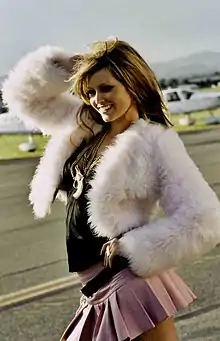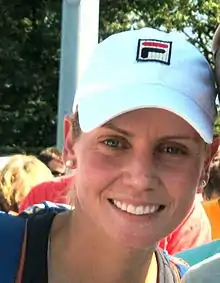Serbian Australians
Serbian Australians[a] (Serbian: Cрпски Аустралијанци/Srpski Australijanci), are Australians of ethnic Serb ancestry. In the 2021 census there were 94,997 people in Australia who identified as having Serb ancestry, making it a significant group with the global Serb diaspora.[1][2][3]
| Total population | |
|---|---|
| Regions with significant populations | |
| Sydney, Melbourne | |
| Languages | |
| Australian English, Serbian | |
| Religion | |
| Traditionally Serbian Orthodox | |
| Related ethnic groups | |
| Other Serbian diaspora groups, Montenegrin Australian, Croatian Australian and Bosnian Australian |
| Part of a series on |
| Serbs |
|---|
 |
History
During the time of Federation a very small number of Serbs inhabited Australia. Despite a lack of accurate data it is assumed that ethnic Serbs deriving from Lika, Dalmatia and Montenegro did reside in largely mining communities throughout the Commonwealth, though exact numbers are unsubstantiated. The first significant, albeit small wave of Serbian migrants, comprising mostly former POWs, and displaced persons fleeing war and genocide began arriving in Australia as post-war immigrants.[4][5] This initial wave also included members of the royalist Chetnik movement fleeing political persecution by the Communist regime of Josip Broz Tito.[6][7][8]
The easing of emigration restrictions by Yugoslavia generated a second, larger wave of predominantly economic migration throughout the 1960s and 1970s. An agreement between Australia and Yugoslavia facilitated the recruitment of largely unskilled and semi-skilled immigrants, from predominantly rural backgrounds to work in Australia's manufacturing and construction industries.[9] The developing political and economic issues in Yugoslavia during the 1980s, alongside its disintegration, ensuing wars, economic sanctions, and hyperinflation of the 1990s, resulted in the largest Serbian migration to Australia.[10][11][12]
Classification issue
For many years Serbian Australians were classified "Yugoslavs" as flawed Australian census data failed to recognise the diverse ethnic groups within the former Yugoslavia. Questions regarding ancestral heritage were not included in any Australian census until 1986.[13][14] From 1971- 1991 Yugoslavian nationals ranked 4th largest in Australia's post-war migrant intake. Census data has established that Serbs ranked 3rd within the Yugoslav immigrant pool, behind declared Croat and Macedonian ethnicities.[15]
Demographics

Serbian Australians comprise 0.36% of Australia's population, with 69.67% residing in the states of New South Wales and Victoria alone. Serbs reside mainly in state capitals and major metropolitan areas throughout Australia. The largest Serbian communities can be found predominantly in Melbourne's western and south-eastern suburbs, and in Sydney's south-eastern suburbs.[16][17][18][19]
| States and territories | Serbian Australian population | |
|---|---|---|
| New South Wales | 36,056 | |
| Victoria | 30,133 | |
| Queensland | 10,121 | |
| Western Australia | 8,563 | |
| South Australia | 7,329 | |
| Australian Capital Territory | 2,191 | |
| Tasmania | 469 | |
| Northern Territory | 142 | |
Ancestry
Ancestral composition of Serbian Australians as declared in the census (2016)
The Australian Bureau of Statistics allows the provision of two ancestries in a multi-response question. In the 2016 census there were 73,901 people in Australia of Serbian descent, 0.31% of the total population. 67.06% of Serbian Australians declared full Serbian ancestry. Individuals identifying as Serbian in the first response comprised 11.84%, whilst 21.09% declared Serbian heritage in the second response.[20][19]
Countries of origin
Serbian Australians by country of birth according to 2016 census data
Religion
Religion of Serbian Australians as declared in the census (2016)
Serbian Australians predominantly belong to the Serbian Orthodox Church of the Eastern Orthodox faith, estimated at approximately 75%. This is due to a statistical discrepancy amongst Serb Australians affiliated within the "Christianity (defined and not defined)" category in the 2016 Australian census. The largest religious body of Serbian Orthodox Australians is the Serbian Orthodox Eparchy of Australia and New Zealand, located in Alexandria, Sydney.[21][22]

17.4% of Serbian Australians declared "No Religion/Not Stated", 5.7% "Roman Catholic" whilst 1.4% professed "other faith's".[19]
Notable people
 | .jpg.webp) |  |  |  |  |  |  | .jpg.webp) |  | .png.webp) |
| Part of a series on |
| Serbs |
|---|
 |
- Alex Antic – Australian senator[23]
- Eli Babalj – Soccer player
- Milan Blagojevic – Soccer player
- Pedj Bojic – Soccer player
- Nick Cotric - Rugby league player
- Nik Cubrilovic - Hacker and internet security expert.[24]
- Miloš Degenek – Soccer player
- Biljana Dekic – Chess player
- Bobby Despotovski – Soccer player and coach[25]
- Bronko Djura - Cricket and Rugby league player
- Dirty South – Musician
- Jelena Dokić – Tennis player
- Dragan Durdevic – Rugby league player
- Ivan Ergić – Soccer player
- Vedrana Grbović – Model[26]
- Dan Ilic – Comedian
- Luke Ivanovic – Soccer player
- Milan Ivanović – Soccer player
- Marko Jesic – Soccer player
- Robert Jovicic – Immigration case
- Sam Kekovich – Australian Rules footballer & media personality
- Ksenija Lukich – Model & TV presenter
- Aleks Marić – Basketball player
- Steven Marković – Basketball player
- Zdravko Micevic – Boxer
- Katrina Milosevic - Actress
- Danny Milosevic – Soccer player
- Nik Mrdja – Soccer player
- Andrew Nikolic – Australian politician and former Australian Army Brigadier
- Bojana Novakovic – Actress
- Abdullah Numan – Mufti of Serbia[27]
- Tom Opacic - Rugby League player
- Andreja Pejic – Model.[28]
- Vedrana Popovic – Soccer player
- Monika Radulovic – Model[29]
- Rale Rašić – Soccer coach,
player and media personality
- Nikola Roganovic – Soccer player
- Tom Rogic – Soccer player
- Siluan - Metropolitan of Australia and New Zealand[30]
- Karl Stefanovic – TV presenter & journalist
- Peter Stefanovic – TV presenter & journalist
- Daniel Subotic – Socialite
- Aleksandar Šušnjar – Soccer player
- Vuko Tomasevic – Soccer player
- Nick Cotric - Rugby league player
- Jake Trbojevic – Rugby league player
- Tom Trbojevic – Rugby league player
- Doug Utjesenovic - Soccer player
- Holly Valance – Actress, singer and model
- Olympia Valance – Model and actress
- Dragan Vasiljković – Serbian paramilitary leader
- Lazar Vidovic – Australian rules footballer
- Tyla-Jay Vlajnic - Soccer player
- Nick Vujicic – Christian evangelist
- Danny Vukovic – Soccer player
- B. Wongar – Writer
- Ursula Yovich – Actress and singer
- Lew Zivanovic – Rugby league player
- Alexandar Popovic – Soccer player
See also
Annotations
References
- "Cultural diversity: Census, 2021 | Australian Bureau of Statistics". www.abs.gov.au. 7 April 2022. Retrieved 5 July 2022.
- "Serbian Culture - Serbians in Australia". Cultural Atlas. Retrieved 23 August 2020.
- "Serbia-born Community Information Summary" (PDF). homeaffairs.gov.au. 2018. Retrieved 23 August 2020.
- "Introduction | Serbian ancestry | CRC NSW". multiculturalnsw.id.com.au. Retrieved 28 August 2020.
- "Serbians in South Australia | Adelaidia". adelaidia.history.sa.gov.au. Retrieved 28 August 2020.
- "Vojislav Stojkovic, Yugoslavian (Serbian) Migrant, 1948". Museums Victoria Collections. Retrieved 28 August 2020.
- Leustean, Lucian N. (30 May 2014). Eastern Christianity and Politics in the Twenty-First Century. Routledge. ISBN 978-1-317-81865-6.
- Stefanovic, D.S. (2002). "Serbs". In James Jupp (ed.). The Australian People: An Encyclopedia of the Nation, its People and their Origins. Cambridge: Cambridge University Press. p. 678. ISBN 978-0-521-80789-0.
- Statistics, c=AU; o=Commonwealth of Australia; ou=Australian Bureau of (19 June 1997). "Chapter - Composition: Birthplace of overseas-born Australians". www.abs.gov.au. Retrieved 28 August 2020.
{{cite web}}: CS1 maint: multiple names: authors list (link) - "Immigration History from Serbia to Victoria". origins.museumsvictoria.com.au. Retrieved 28 August 2020.
- "The Trials of Growing up Serbian Abroad". Balkan Insight. 22 August 2018. Retrieved 28 August 2020.
- "Discover Victoria's diverse population". www.vic.gov.au. Retrieved 28 August 2020.
- Statistics, c=AU; o=Commonwealth of Australia; ou=Australian Bureau of. "Fact sheet - Ancestry". www.abs.gov.au. Retrieved 28 August 2020.
{{cite web}}: CS1 maint: multiple names: authors list (link) - Statistics, c=AU; o=Commonwealth of Australia; ou=Australian Bureau of. "Fact sheet - Ancestry - Serbian". www.abs.gov.au. Retrieved 28 August 2020.
{{cite web}}: CS1 maint: multiple names: authors list (link) - corporateName=Commonwealth Parliament; address=Parliament House, Canberra. "Top 10 countries of birth for the overseas-born population since 1901". www.aph.gov.au. Retrieved 28 August 2020.
{{cite web}}: CS1 maint: multiple names: authors list (link) - "Cultural diversity: Census, 2021 | Australian Bureau of Statistics". www.abs.gov.au. 7 April 2022. Retrieved 6 July 2022.
- The People of Australia – Statistics from the 2011 Census (PDF). Department of Immigration and Border Protection. 2014. p. 59. ISBN 978-1-920996-23-9.
Ancestry
- School of Historical Studies, Department of History. "Serbs - Entry - eMelbourne - The Encyclopedia of Melbourne Online". www.emelbourne.net.au. Retrieved 5 September 2020.
- "Svetosavnik". Svetosavnik - Parorhiski List Srpske Pravoslavne Crkve "Sv Sava" (in Serbian and English). 123: 20–26. 9 August 2016.
- Statistics, c=AU; o=Commonwealth of Australia; ou=Australian Bureau of. "Fact sheet - Ancestry". www.abs.gov.au. Retrieved 30 August 2020.
{{cite web}}: CS1 maint: multiple names: authors list (link) - "Serbian Culture - Religion". Cultural Atlas. Retrieved 29 August 2020.
- "Serbian Orthodox Church Australia and New Zealand - HOME". soc.org.au. Retrieved 29 August 2020.
- Antic, Alex (17 September 2019). "First speech". Hansard. Parliament of Australia. Retrieved 1 December 2019.
- "One Serb's Crusade Against his Privacy Being Invaded by Facebook". Britić.
- "Bobby admits salute". The World Game. Retrieved 29 August 2020.
- "Bivša Miss Srbije Vedrana Grbović: Đoković me nasmejao do suza!". Svet.
- "ABDULLAH ef. NUMAN". www.rijaset.rs (in Serbian). Retrieved 6 February 2021.
- "Naš Andrej je lep ko lutka!" [Our Andrej Is Beautiful Like a Doll!]. Alo! (in Serbian). 31 December 2011. Archived from the original on 9 January 2012. Retrieved 31 December 2011.
- "Srpkinja sa titulom Mis Australije: Upoznajte Moniku Radulović". Cosmopolitan.
- "Serbian Orthodox Church Australia and New Zealand - BIOGRAPHY OF BISHOP SILUAN (MRAKIC) NEWLY CONSECRATED BISHOP OF THE METROPOLITANATE OF AUSTRALIA AND NEW ZEALAND". soc.org.au. Retrieved 10 November 2021.
